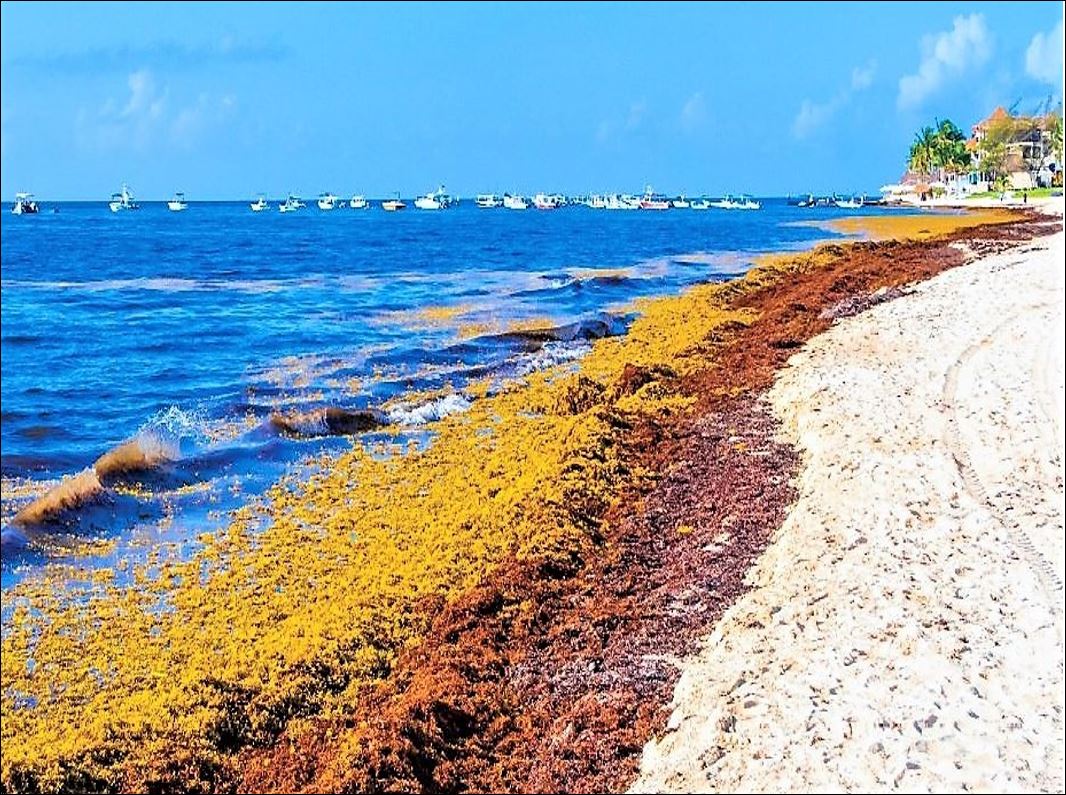Last year’s 5,500-mile-long swath of yellow-brown seaweed stretching over the Atlantic Ocean from West Africa to the Gulf of Mexico was called the Great Sargassum Belt. Perhaps what’s growing out there this year should be christened “colossal.”
Researchers at the University of South Florida’s satellite-based Sargassum Watch System said last year’s sargassum bloom was so big it posed challenges on a hemispheric scale for marine ecosystems and coastal towns in terms of tourism, fishing and marine life.
The size of this upcoming summer’s fledgling bloom is already setting records.
“Sargassum abundance in the interior central Atlantic increased, but it increased so substantially that the abundance reached a new record from all previous December months,” the USF sargassum experts published online. “This indicates that 2024 will be another major sargassum year.”
The weight of last year’s sargassum belt was estimated to be 13 million tons at its peak. Going into this month, researchers predicted its weight was already approaching 5 million tons, which is up from 1 million tons in November.
The USF College of Marine Science will receive about half of a $3.2-million grant from the NOAA Monitoring and Event Response for Harmful Algal Blooms program, which is a five-year collaboration that aims to better forecast sargassum blooms and to discover how to prevent them from plaguing coastal communities.
Parts of the Sunshine State’s coastline, particularly along the eastern shores of the Florida Keys, were among the beaches that had to contend with environmental, economic and social challenges due to feet-deep accumulations of sargassum last year.
Galveston and South Padre Island along Texas’ Gulf Coast saw substantial amounts of Sargassum washing ashore, as did islands in the eastern Caribbean such as Barbados, Trinidad and Tobago, and St. Lucia faced severe impacts.
There was so much sargassum it also inundated West African coastal countries such as Ghana and Senegal.
Related stories
- Massive swath of brown algae angles toward Southwest Florida beaches, but do we need to worry?
- Meet the sargassum belt a 5-000-mile-long snake of seaweed circling Florida
- Giant blobs of seaweed are hitting Florida that’s when the real problem begins
Sargassum piling up feet-deep on many of the beaches, day after day, poses challenges for local authorities on how to clear the beach and minimize impacts on tourism and marine habitats.
As the seaweed decomposes it becomes unsightly, attracts insects, smells like rotten eggs as it emits hydrogen sulfide and causes other environmental headaches such as smothering turtle nesting sites, increasing hatchling deaths and causing fish kills.
The Optical Oceanography Laboratory at USF’s College of Marine Science tracks the seaweed from where it originates, which is a region of the tropical Atlantic known as the Sargasso Sea where the huge mats of yellow-brown algae swirl about on ocean currents. Toward the summer the mats drift throughout the Caribbean and Gulf of Mexico.
Floating in the ocean sargassum mats are standalone ecosystems important to many marine animals. It provides fish, shrimp, crabs and turtles with food, shade and protection from predators. On the beach, sargassum may serve as fertilizer for plants that grow on dunes and thus contribute to shoreline stability. The seaweed is also being studied as a possible source of pharmaceutical materials.
USF’s College of Marine Sciences will be working with Florida Atlantic University, the Caribbean Coastal Ocean Observing System, NOAA’s Atlantic Oceanographic and Meteorological Laboratory, and the U.S. Virgin Islands Department of Planning and Natural Resources on NOAA’s $3.2 million grant to improve satellite-based sargassum forecasting.
“The goal is to be able to put a single beach on alert when a sargassum inundation is imminent, instead of alerting the entire Caribbean,” said Brian Barnes, a USF oceanographer. “This increased level of resolution will give coastal resource managers more time to prepare for and ameliorate the effects of inundation events.”
Environmental reporting for WGCU is funded in part by VoLo Foundation, a nonprofit with a mission to accelerate change and global impact by supporting science-based climate solutions, enhancing education, and improving health.
9(MDEwNzczMDA2MDEzNTg3ODA1MTAzZjYxNg004))






